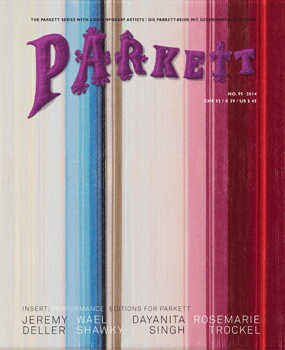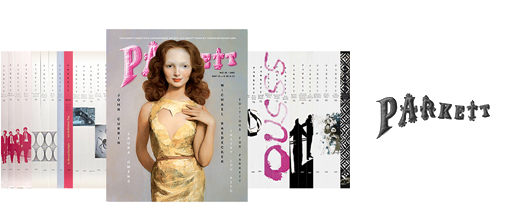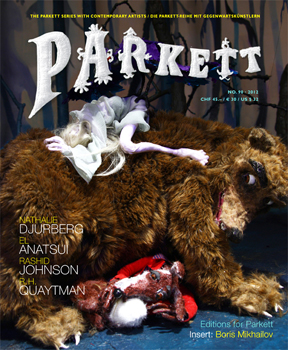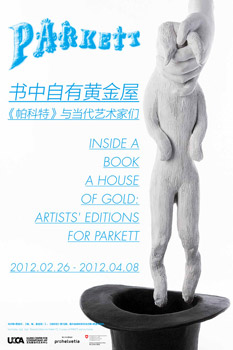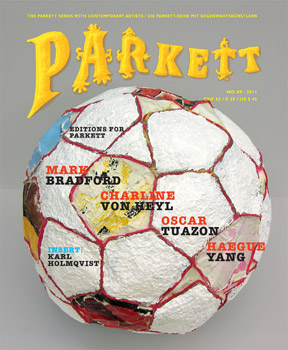New Parkett with Carol Bove, Josiah McElheny, Philippe Parreno, and John Baldessari and more.
The new volume and the four new artists’ editions will be presented at Parkett’s booth at Frieze in London this coming week, together with the new catalogue raisonné “200 Artworks – 25 Years”.
Parkett 86 features Francesco Bonami in conversation with Benjamin H.D. Buchloh negotiating the relevance and authority of the critic, curator, and artist in today’s art world, and the necessity for their respective “antibodies” to resist mainstream consensus. A dialogue between Jay Sanders and John Knight wrestles problems of hyper-design, retrospective models, and bibliographic homogeneity. The issue also includes an insert by Francis Stark and a spine designed by Josh Smith. Parkett 86 continues its 25th anniversary celebration with Marc von Schlegell’s “evaporated essay,” which teases notions of the “transatlantically deluded” in a series of orphaned endnotes.
Parkett patron saint John Baldessari returns to its pages in a special anniversary collaboration. James Welling’s conversation with the artist volleys images and verbiage particularly catalytic for Baldessari over the years, from eyebrows and foreheads to cheeky puns like GOD NOSE. Alexander van Grevenstein also reacts to Baldessari’s trademark double entendres, and Rainer Fuchs astutely regards Baldessari’s practice of “revealing by concealing.” In Baldessari’s nine-color silkscreen print on plexiglass, a cropped photograph of a furrowed forehead and raised eyebrow is wired like basic electric circuitry to three ruled lines (green, orange, and purple) on a pale blue ground.
In a conversation with Carol Bove, Parkett’s Senior Editor US, Bettina Funcke, comments on the pastiche evinced in Bove’s diverse genres and emblems of extinct countercultures. Through her delicate revamping and staging of cast-off “gem detritus”—diamonds, indeed, plucked from the rough—Bove embraces the sustained fetishistic and connotative powers of, as Martin Herbert aptly notes, driftwood wormholes to Surrealism and sixties beat-ins. Then there’s Bove’s attention to the book-object, a topic fertilized in the artist’s conversation with independent book connoisseur Philip Smith, whose generous digressions take us inside any book collector’s ultimate fantasy. In Bove’s edition for Parkett, thirty-five unique, freestanding brass frames suspend found, natural, and at times freakish artifacts which have been gathered over many weeks of Bove’s famously dreamy hikes.
From the Big Bang to Borgesian mirrors, technology to toys, the work of Josiah McElheny lends itself to a myriad of room-filling inclinations. Branden Joseph traces the lineage of his robust work, and identifies a nexus between McElheny’s futuristic, brainy, literally reflective works. Tom McDonough points to the Bauhaus allusions in his “glass decanters [that] perform in… a cinema of infinite space.” In his conversation with Lynne Cooke, McElheny’s verbal gymnastics twirl and flip through lessons of historical production in industry and art—together they guide us precariously through intersections of opposing interpretation and hypothesis. McElheny’s edition for Parkett features joined multi-colored glass panels, laminated with low-iron chrome mirrors, resulting in a geometry of tinted reflections.
The cantilevered marquee that Philippe Parreno prosthetically adhered to the Guggenheim facade lent the opening of Theanyspacewhatever (2008) show the ambience of a Hollywood premier. Yet this subtle and allusive French-born “relational” artist is well known to those who never quite know what he’s up to, or what he’ll go on to do next. Hans Ulrich Obrist’s interview with Parreno threads together aspects of his poetic and appropriationistic methodology, which ranges to regions as diverse as magic and illusionism. Liam Gillick notes Parreno’s masterful enunciation of details through what he calls a “storyboard methodology,” and Luc Lagier addresses the confluence of violence and spectatorship, soccer stars and cinematography in his increasingly seminal body of work. Zoe Stillpass, too, relates with a hint of nostalgia to Parreno’s films, telling the story of her own part in one of Parreno’s film-portraits. For his Parkett edition, Parreno has once again “inverted the obvious” with his own brand of foxy, nonchalant interventionism—this time laboriously hand-scribing and annotating the entirety of the commissioned texts from his own section of Parkett #86. The result is twenty-seven single sheets, front and back, of essays on himself in his own handwriting, each edition consisting of one framed sheet from the collection.

